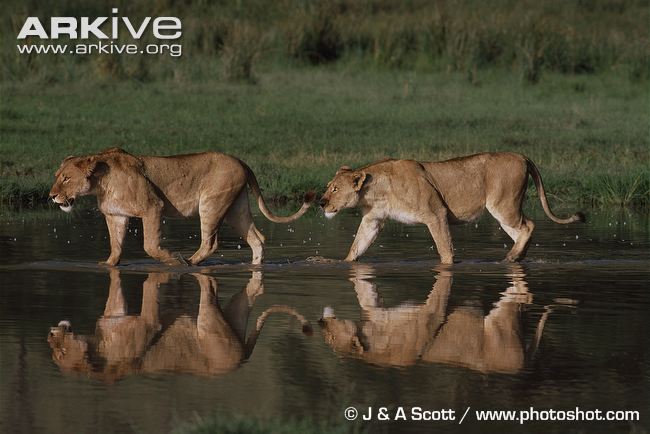Post by dinosauria101 on Feb 19, 2019 21:45:06 GMT 5
Lion - Panthera leo
The lion (Panthera leo) is one of the four big cats in the genus Panthera, and a member of the family Felidae. With some males exceeding 250 kg (550 lb) in weight, it is the second-largest living cat after the tiger. Wild lions currently exist in Sub-Saharan Africa and in Asia with an endangered remnant population in Gir Forest National Park in India, having disappeared from North Africa and Southwest Asia in historic times. Until the late Pleistocene, about 10,000 years ago, the lion was the most widespread large land mammal after humans. They were found in most of Africa, across Eurasia from western Europe to India, and in the Americas from the Yukon to Peru. The lion is a vulnerable species, having seen a possibly irreversible population decline of thirty to fifty percent over the past two decades in its African range. The African lion is a very large cat, with males weighing between 330 and 550 pounds, averaging 190 kg (418 lbs). It is 8 to 10 feet long, not including the tail. Its most famous feature is its mane, which only male lions have. The mane is a yellow color when the lion is young and darkens with age. Eventually, the mane will be dark brown. The body of the African lion is well suited for hunting. It is very muscular, with back legs designed for pouncing and front legs made for grabbing and knocking down prey. It also has very strong jaws that enable it to eat the large prey that it hunts.

Lioness (pride of 2) - Panthera leo
The lioness (Panthera leo) is one of the four big cats in the genus Panthera, and a member of the family Felidae. Wild lions currently exist in Sub-Saharan Africa and in Asia with an endangered remnant population in Gir Forest National Park in India, having disappeared from North Africa and Southwest Asia in historic times. Until the late Pleistocene, about 10,000 years ago, the lion was the most widespread large land mammal after humans. They were found in most of Africa, across Eurasia from western Europe to India, and in the Americas from the Yukon to Peru. The lion is a vulnerable species, having seen a possibly irreversible population decline of thirty to fifty percent over the past two decades in its African range. The African lioness is a very large cat, weighing between 260 and 400 pounds, averaging 130 kg (286 lbs). It is 8 to 10 feet long, not including the tail. The body of the African lioness is well suited for hunting. It is very muscular, with back legs designed for pouncing and front legs made for grabbing and knocking down prey. It also has very strong jaws that enable it to eat the large prey that it hunts.

Credit to Wikipedia
The lion (Panthera leo) is one of the four big cats in the genus Panthera, and a member of the family Felidae. With some males exceeding 250 kg (550 lb) in weight, it is the second-largest living cat after the tiger. Wild lions currently exist in Sub-Saharan Africa and in Asia with an endangered remnant population in Gir Forest National Park in India, having disappeared from North Africa and Southwest Asia in historic times. Until the late Pleistocene, about 10,000 years ago, the lion was the most widespread large land mammal after humans. They were found in most of Africa, across Eurasia from western Europe to India, and in the Americas from the Yukon to Peru. The lion is a vulnerable species, having seen a possibly irreversible population decline of thirty to fifty percent over the past two decades in its African range. The African lion is a very large cat, with males weighing between 330 and 550 pounds, averaging 190 kg (418 lbs). It is 8 to 10 feet long, not including the tail. Its most famous feature is its mane, which only male lions have. The mane is a yellow color when the lion is young and darkens with age. Eventually, the mane will be dark brown. The body of the African lion is well suited for hunting. It is very muscular, with back legs designed for pouncing and front legs made for grabbing and knocking down prey. It also has very strong jaws that enable it to eat the large prey that it hunts.

Lioness (pride of 2) - Panthera leo
The lioness (Panthera leo) is one of the four big cats in the genus Panthera, and a member of the family Felidae. Wild lions currently exist in Sub-Saharan Africa and in Asia with an endangered remnant population in Gir Forest National Park in India, having disappeared from North Africa and Southwest Asia in historic times. Until the late Pleistocene, about 10,000 years ago, the lion was the most widespread large land mammal after humans. They were found in most of Africa, across Eurasia from western Europe to India, and in the Americas from the Yukon to Peru. The lion is a vulnerable species, having seen a possibly irreversible population decline of thirty to fifty percent over the past two decades in its African range. The African lioness is a very large cat, weighing between 260 and 400 pounds, averaging 130 kg (286 lbs). It is 8 to 10 feet long, not including the tail. The body of the African lioness is well suited for hunting. It is very muscular, with back legs designed for pouncing and front legs made for grabbing and knocking down prey. It also has very strong jaws that enable it to eat the large prey that it hunts.

Credit to Wikipedia









